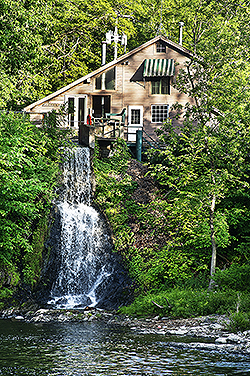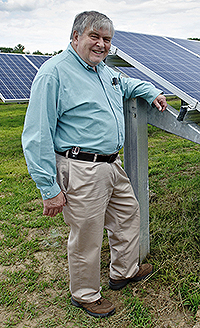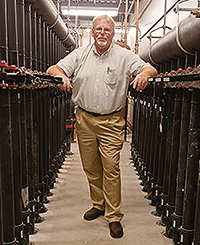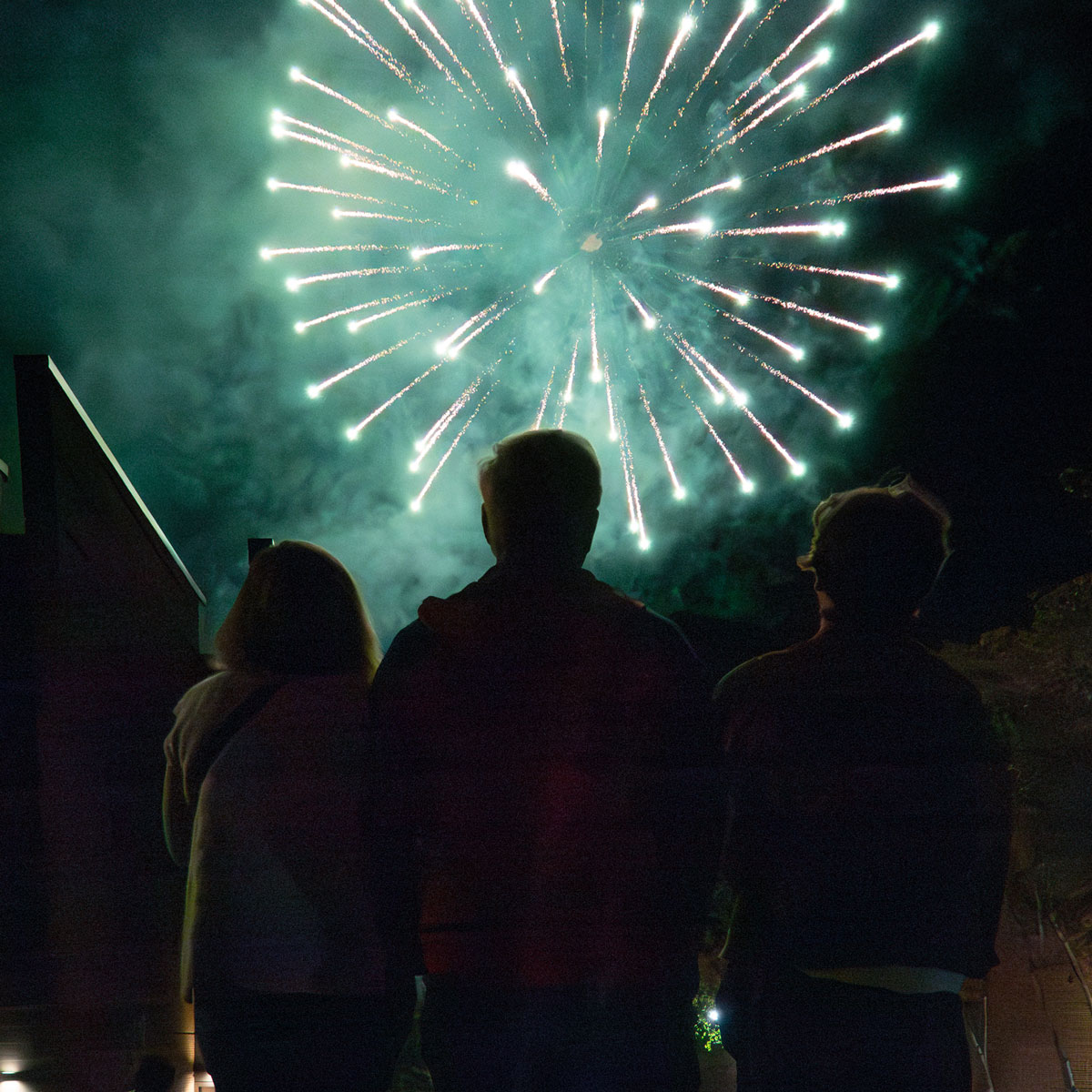Greenspace: Skidmore's environmental strategy embraces every spot on campus, and beyond
Ranks of loaner bikes outside Scribner Library, a large garden with a tool shed on Wiecking Hall lawn, a plug-in kiosk for electric cars in Palamountain parking lot—Skidmore's campus looks a lot different than it did just a few years ago. It's not only joining the national boom in campus greening, but it's pioneering some renewable-energy initiatives that most campuses have never heard of. Below are just a few highlights; the Skidmore Sustainability Map shows what's green where.
Dam fine idea

The Chittenden Falls dam, about an hour's
drive south of campus
In 2012, a confluence of bad news and good news generated a particularly creative thought in the minds of Mike Hall and, just across town, Omay Elphick '93. The bad news was that many small hydroelectric dams in New York State were growing old, needing repairs, and earning insufficient incomes from depressed electricity prices. The good news was the state legislature's supporting of renewable energy by allowing "remote net metering," whereby renewable energy can be generated in one location and credited to its producer in another location. A renewables advocate and developer, Elphick says the legislation was "an aha moment" for him. And Hall, Skidmore's longtime former budget director and now its specialist for energy projects, says, "I immediately jumped on the idea of a small hydro project for Skidmore."
Very few colleges are involved with hydro power, except perhaps to buy some through their regular energy companies. Cornell has long operated two hydroelectric generators providing about 1,700 kwh per year, and Western Technical College in Wisconsin has started up a dam. But Skidmore's plans put it in a whole different league. Hall partnered with Elphick as director of power marketing at Gravity Renewables, a firm with small hydro plants and development interests across the country, and they soon settled on a promising dam at Chittenden Falls, about 60 miles south of campus. Skidmore began receiving credit for its electricity in May.
"This is the first project of its kind in the country," according to Elphick, who adds, "There is no How-to Guide to Renewable Energy Development; we're helping to create the field as we go." Even the National Grid power company is learning from its innovative customer: it had to enter the credit on Skidmore's utility bill by hand, says Hall. (Citing "his efforts in helping Skidmore become an early adopter of innovative programs like this, providing significant green energy as well as savings," Mike West, Skidmore's VP for finance and administration, calls Mike Hall "an exemplar for ‘Creative Thought Matters.'" Facing Hall's upcoming retirement, West says he'll "greatly miss his wisdom and experience" in sustainability, emergency management, finance, energy, and other areas.)
The scenic and historic Chittenden Falls dam was built in 1809 to run a paper mill and then refitted to supply electricity to the power grid in 1979. But age has taken a toll. As its new owner, Gravity Renewables has been removing, refurbishing, and reinstalling equipment and completing other upgrades to bring the facility up to date. With Gravity operating the dam on Skidmore's behalf, Elphick explains, "Skidmore's 20-year agreement to buy the power gives it a stable, affordable electricity source and justifies Gravity's capital investment to make the facility viable again. Together we save this solid, existing resource that might otherwise be at risk of rusting away."
"All Skidmore owns is the meter box," notes Hall. "We're getting savings without any up-front investment and without building any infrastructure ourselves." Another bonus: Skidmore has access to the site, including a small building, for teaching and research. Hall is gratified that environmental studies faculty were keen to use the facility for course work, and Elphick says, "I love the academic potential—to study issues from electricity generation to economic development, from policy and tax law to environmental impacts."
Chittenden Falls is expected to supply 4 million kilowatt-hours per year, which is about 18% of Skidmore's total electricity usage.
O! Sunny day

Budget and energy expert Mike
Hall, at Skidmore’s new solar field
Skidmore's second big foray into remote net metering this year is with an eight-acre array of 6,950 solar panels, on part of its Denton Road property. One of the largest photovoltaic arrays in the state, it supplies approximately 2.8 million kilowatt-hours to the power grid each year in return for a utility bill credit, covering 12% of Skidmore's overall electricity needs.
The Association for the Advancement of Sustainability in Higher Education recently counted just 43 campuses with photovoltaic arrays of 1 million kilowatt-hours or more. It's no surprise that two of the biggest are at the University of Arizona and Arizona State. In the wintry northeast, Rutgers has been one of the few—until now.
At Skidmore's site, each row of panels is wired to a junction box leading to a small concrete building where inverters swap the DC power to AC and then transformers step up its voltage to match the high-capacity cables that connect to utility poles just beyond the home-run fence of Castle Baseball Diamond.
Again Skidmore had no major costs up front; it doesn't own the panels and equipment, which were installed by Dynamic Solar, but simply has a long-term contract for the energy they generate—another case of "creative partnering," according to Hall. And with $2.35 million in grants from the New York State Energy Research and Development Authority, through the NY-Sun program, it was also a case of "making the most of grant opportunities."
The creative partnering also involved the Town of Greenfield for permitting. As a pioneering project, the solar field raised some aesthetic concerns among local residents, which Skidmore addressed with landscape screening and other measures. "So we're being good community neighbors," Hall observes, "even beyond reducing our carbon footprint."
On a smaller scale, Skidmore this summer introduced rooftop solar on the Kimball, Penfield, Wilmarth, and McClellan residence halls and the Van Lennep Stables. The 10 thermal-solar panels on each roof will provide some of the buildings' domestic hot water in winter and all in summer.
Groundswell

Project manager Paul Lundberg in a
campus geothermal facility
"I liken it to getting free fuel for life," Hall says of Skidmore's sustainable heating and air-conditioning systems. Using the steady underground temperature of about 50 degrees year-round, geothermal technology provides most of the heating and all the cooling needs for Skidmore's two large apartment complexes and seven other buildings across campus. Much of the time, he notes, the only fuel usage for geothermal is a little electricity to run the pumps that circulate fluid deep underground and into the buildings' ductwork.
"With Paul Lundberg, our lead project manager in facilities services, I pushed for geothermal from day one," Hall says. Once Skidmore learned that its underlying campus geology was favorable, around 2004, it dug its first geothermal wells as part of the new Northwoods Village apartment complex. There, utility bills are so low that the savings paid for the initial higher costs of installation within three or four years. "There's no question that geothermal is very green and clean environmentally," Hall says, "so as soon as we could see that it would pay off financially, we got right into it."
Lundberg, guiding the implementation of geothermal in new and existing buildings, also spearheaded a plan for sharing unneeded geothermal heating and cooling from idle or empty buildings at times when a nearby building experiences more demand, a system that helped Skidmore win a 2012 prize from the national Association for the Advancement of Sustainability in Higher Education.
Now on Lundberg's mind is the planned Center for Integrated Sciences. Its four floors of lab equipment and people, he says, will make it "a cooling-predominant building. So if we calculate for its cooling demands, we know we'll be well covered for its heating." One key to efficiency in drilling a geothermal field is efficiency in building design. Lundberg asserts, "We've been diligent in engineering the CIS—co-locating vent hoods and animal-care rooms, for instance, and the shared spaces help keep the footprint reasonable—so this is a facility that really merits an alternative energy system."
Skidmore now accomplishes about 40% of its heating and cooling with geothermal. Going forward, Hall says, the strategy for all new buildings and all repairs to existing heating and cooling systems "includes considering whether geothermal would be a good option."
Fiat lux
All over campus, more than 550 outdoor light fixtures were upgraded in the past few years, to fit them with induction lighting, which is more efficient even than compact fluorescent bulbs. The utility-bill savings have been significant ever since.
Dan Rodecker, Skidmore's facilities director, says, "We'd have gone with super-efficient LEDs, except that we'd have had to replace the entire fixtures, and they still had a lot of life in them." But LEDs are making inroads fast. The 2012 renovations in Scribner Library brought in lots of LEDs, thanks to a NYSERDA incentive. And now that the technology is more affordable, Lundberg reports, he and his colleagues are testing some LED office lighting in their own workspaces. He says, "The beauty of LEDs is that they use 20% less electricity than compact fluorescents, last for 10 years or more, and give off almost zero heat."
Shameless plug
Electric cars are just in their infancy, but Skidmore is serving as a proud nanny. Taking advantage of a promotion offered by the National Grid power company, the campus is now home to a free recharging station for cars with plug-in batteries. The charging kiosk serves two parking spaces in the busy and popular Palamountain Hall lot (where it was easy to connect to existing wires inside the building). Drivers can use a National Grid card or a smartphone application to turn on the juice and charge their parked cars. A sign asks gas-powered vehicles to park elsewhere and requests that users limit their charging time to three hours. Lundberg knows of one employee who's a regular at the charger. He admits, "Right now, it's more just a message we're sending, that we want to help our community get on board with newer, cleaner transportation choices. But I could foresee our needing, and offering, several more such stations in the future."
Another transportation option is the Capital District bus service that was brought to Saratoga with the help of Mike Hall. Skidmore students provide ridership (for free, thanks to Skidmore's subsidy) to keep the routes operating, even into the wee hours on weekends, and Skidmore no longer has to run its own shuttles between campus and downtown.
Reduce, reuse, rethink, recreate
In embracing and even spearheading innovations in sustainability, Skidmore has been transforming its campus, from its rooftops to its geological foundations. Water-bottle refill taps in several buildings are used thousands of times a year; no-sort recycling bins are diverting more and more waste into recycling rather than the landfill; even campus lawns and flowerbeds get fewer, safer chemical treatments.
Remarkably, as the campus has grown to meet new student and program needs—including 22 new apartment buildings and the large Zankel Music Center—its natural-gas usage and its electricity costs have dropped markedly. It's a practical matter as well as an ethical and educational mission. By being resourceful with finite natural and budgetary resources, Skidmore seems to have figured out how to do, quite literally, more with less, and how to sustain that sustainable model into the future.


